Characteristic features, Classification, Economic importance, structure, Reproduction - Gymnosperms | 11th Botany : Chapter 2 : Plant Kingdom
Chapter: 11th Botany : Chapter 2 : Plant Kingdom
Gymnosperms

![]()
![]()
![]()
![]() Gymnosperms
Gymnosperms
Naked Seed producing Plants
Michael Crichton’s Science fiction in a book
transformed into a Film of Steven Spielberg (1993) called Jurassic Park. In this film you might have noticed insects embedded
in a transparent substance called amber which preserves the extinct forms. What
is amber? Which group of plants produces Amber?

Amber is a plant secretion that is a efficient
preservative that doesn’t get degraded and hence can preserve remains of
extinct life forms. The amber is produced by Pinites succinifera, a
Gymnosperm.
In this chapter we shall discuss in detail about
one group of seed producing plants called Gymnosperms.
Gymnosperms (Gr. Gymnos = naked; sperma= seed) are
naked seed producing plants. They were dominant in the Jurassic and cretaceous
periods of Mesozoic era. The members are distributed throughout the temperate
and tropical region of the world
1. General characteristic features
•
Most of the gymnosperms are evergreen woody trees
or shrubs. Some are lianas (Gnetum)
•
The plant body is sporophyte and is differentiated
into root, stem and leaves.
•
A well developed tap root system is present.
Coralloid Roots of Cycas have
symbiotic association with blue green algae. In Pinus the roots have mycorrhizae.
![]()
![]()
![]()
•
The stem is aerial, erect and branched or
unbranched (Cycas) with leaf scars.
•
In conifers two types of branches namely branches
of limited growth (Dwarf shoot) and Branches of unlimited growth (Long shoot)
is present.
•
Leaves are dimorphic, foliage and scale leaves are
present. Foliage leaves are green, photosynthetic and borne on branches of
limited growth. They show xerophytic features.
•
The xylem consists of tracheids but in Gnetum and Ephedra Vessels are present.
•
Secondary growth is present. The wood may be Manoxylic (Porous, soft, more
parenchyma with wide medullary ray -Cycas)
or Pycnoxylic (compact with narrow
medullary ray-Pinus).
•
They are heterosporous. The plant may be monoecious
(Pinus) or dioecious (Cycas).
•
Microsporangia and Megasporangia are produced on
Microsporophyll and Megasporophyll respectively.
•
Male and female cones are produced.
•
Anemophilous pollination is present.
•
Fertilization is siphonogamous and pollen tube
helps in the transfer of male nuclei.
•
Polyembryony
(presence of many embryo) is Present. The naked ovule
develops into seed. The endosperm is
haploid and develop before fertilization.
•
The life cycle shows alternation of generation. The
sporophytic phase is dominant and gametophytic phase is highly reduced. The
photograph of some of the Gymnosperms is given in Figure 2.38
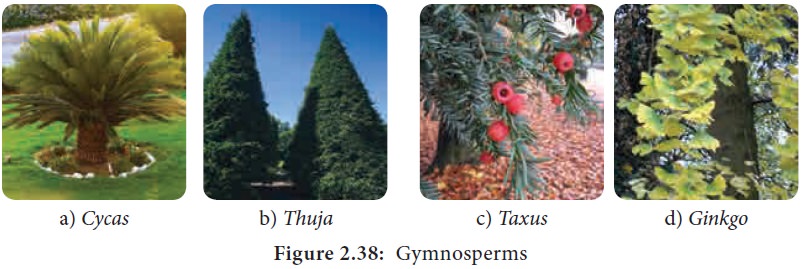
2. Classification of Gymnosperms
Sporne (1965) classified gymnosperms into 3
classes, 9 orders and 31 families. The classes include i) Cycadospsida ii)
Coniferopsida iii) Gnetopsida.
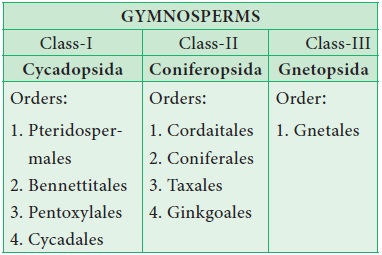
General Characters of Main classes:
Class I – Cycadopsida
•
Plants are palm-like or fern-like.
•
Compound, frond-like pinnate leaves.
•
Manoxylic wood.
•
Sperms are motile.
•
Flower like structures are absent. Strobili are
simple.
Example: Cycas,
Zamia.
Class II – Coniferopsida
•
Tall trees with simple leaves of varied shape.
•
Wood is pycnoxylic.
•
Cone like strobili are present.
• Motile sperms are absent (except Ginkgo biloba). Example: Pinus.
Class III – Gnetopsida
•
Shrubs, trees and lianas.
•
Leaves are elliptical or strap-shaped, simple,
opposite or whorled.
•
Motile sperms are absent.
•
Wood contains vessels.
•
Strobili is called as inflorescence.
•
Flower like structure with perianth is present.
Example: Gnetum, Ephedra.
2. Comparison of Gymnosperm with Angiosperms
Gymnosperms resemble with angiosperms in the following features
•
Presence of well organised plant body which is differentiated
into roots, stem and leaves.
•
Presence of cambium in gymnosperms as in
dicotyledons.
•
Flowers in Gnetum
resemble to the angiosperm male flower. The Zygote represent the first cell of
sporophyte.
•
Presence of integument around the ovule.
•
Both plant groups produce seeds.
•
Pollen tube helps in the transfer of male nucleus
in both.
•
Presence of Eustele.
The difference between Gymnosperms and Angiosperms
were given in Table 2.5
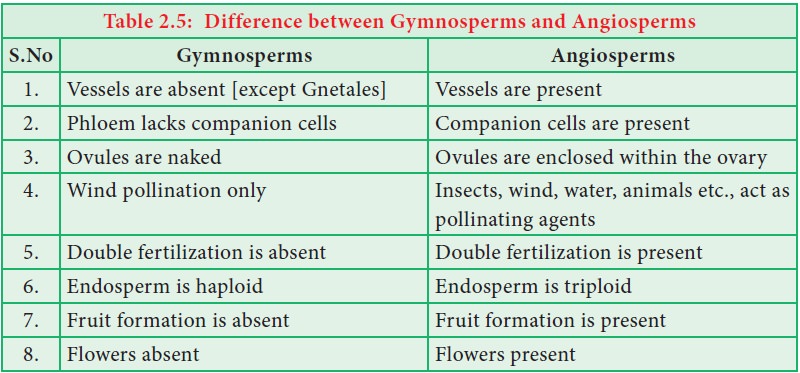
3. Economic importance of Gymnosperms

4. Cycas
Class–Cycadopsida
Order – Cycadales
Family- Cycadaceae
Genus - Cycas
It is widely distributed in tropical and sub
tropical region of eastern hemisphere of the world. Cycas revoluta, Cycas
beddomei, Cycas circinalis, Cycas
rumphii are some of the common
species. The plant body is sporophyte and resemble a small palm. The growth is
very slow. It is evergreen and xerophytic in nature.
Sporophyte:-
The sporophyte is differentiated into root, stem
and leaves. The stem is columnar bearing a crown of spirally arranged pinnately
compound leaves (Figure 2.39).
External features

Root
Two types of roots are found in Cycas. They are the tap root and
coralloid root.
The primary root persists and forms the tap root.
Some of the lateral roots give rise to branches which grow vertically upward
below the ground level. They branch repeatedly to form dichotomously branched
coral- like roots called coralloid roots. The cortical region of the coralloid
root contains the Blue green alga – Anabaena
sp. which helps in nitrogen fixation
(Figure 2.40).

Stem
The stem is columnar, unbranched and woody. It is
covered with persistent woody leaf bases. The stem also bears adventitious buds
at the base.
Leaves
Cycas has two
types of leaves
(i) Foliage
or assimilatory leaves
(ii) Scale
leaves
(i) Foliage or assimilatory leaves
Foliage leaves are large, pinnately compound and
form a crown at the top of the stem. Each leaf has 80-100 pairs of sessile leaflets.
The apex is acute or spiny. The leaflet has a single midvein. Lateral veins are
absent. Circinate vernation is present and young leaves are covered with ramenta.
Scale leaves are brown, small, triangular and persistent which are protective in function. They are covered with ramenta.
Internal structure
T.S. of Root
The internal organization of the primary root
reveals the following parts.
1. Epiblema, 2. Cortex 3. Vascular region (Figure
2.41). Epiblema is the outermost layer and is made up of single layered
parenchyma. It is followed by thin walled parenchymatous cortex. The cortex is
delimited by single layered endodermis. A multilayered parenchymatous pericycle
is present and it surrounds the vascular tissue. The xylem is diarch in young
root and tetrarch in older ones. Secondary growth is present. Coralloid root
also shows similar structure but the middle cortex is characterized by the
presence of Algal zone. Blue green alga called, Anabaena is found in
this zone. The xylem is triarch and
exarch.
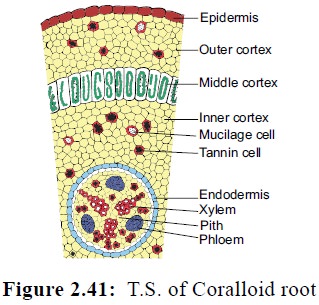
T.S. of Stem
The cross section of young stem is irregular in
outline due to the presence of persistent leaf bases. It is differentiated into
epidermis, cortex and vascular cylinder. It resembles the structure of a dicot
stem (Figure 2.42).
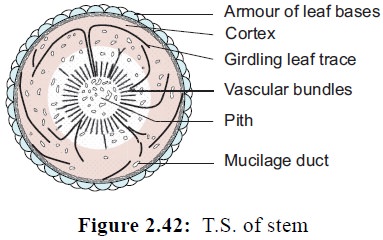
The epidermis is the outermost layer and is covered with thick cuticle. It is discontinuous due to the presence of leaf bases. The cortex constitutes the major part and is made up of thin walled parenchymatous cells. The cells are filled with starch grains. Cortex also possesses several mucilage ducts and tannin cells. In young stem the vascular bundles are arranged in the form of a ring. A broad medullary ray is present. The vascular bundles are conjoint, collateral, endarch and open. Xylem is made up of tracheids and phloem consists of sieve tubes and phloem parenchyma. Companion cells are absent. The cambium present in the vascular bundle is active for short period. The secondary cambium is formed from the pericycle or cortex and helps in secondary growth of the stem. The cortical region shows a large number of leaf traces. The presence of direct leaf traces and girdling leaf trace is the unique feature of Cycas stem. Secondary growth results in polyxylic condition. Phellogen and cork are formed and replace the epidermis.The wood formed belongs to manoxylic type.
T.S. of Rachis
The outermost layer is epidermis and is covered by
thick cuticle. The hypodermis is made up of two layers of sclerenchyma on the
adaxial side and many layered on the abaxial side. The ground tissue is
parenchymatous. The peculiar feature of the rachis is the arrangement of
vascular bundle i.e., in an inverted Omega shape pattern (Figure 2.43). Each
vascular bundle is covered by a single layered sclerenchymatous bundle sheath.
Vascular bundles are collateral, endarch and open. A single layered endodermis
and few layered pericycle surrounds the bundle. A diploxylic condition is
present in the vascular bundles.( presence of both centripetal and centrifugal
xylem).
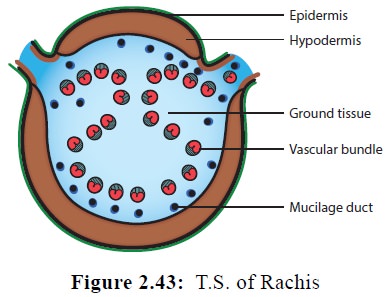
T.S. of Leaflet
The leaflet of Cycas in transverse section shows the presence of upper and lower epidermis. The epidermal cells are thick walled and are covered with thick cuticle. The lower epidermis is not continuous and is interrupted by sunken stomata. The hypodermis consists of sclerenchyma cells to prevent transpiration. The mesophyll is differentiated into palisade and spongy parenchyma.
The cells of this layer are involved in
photosynthesis. The spongy parenchyma present in close proximity to the lower
epidermis bear large intercellular spaces which help in gaseous exchange.
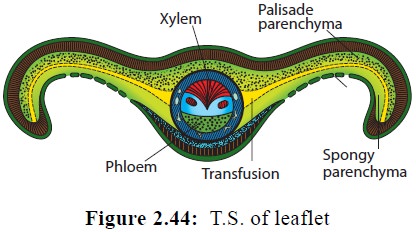
![]()
![]()
![]()
Layers of colourless, elongated cells which run
parallel to the leaf surface from the midrib to the margin of the leaflet are
seen. These constitute the Transfusion
tissue that helps in the lateral
conduction of water. The vascular
bundle has xylem facing upper epidermis and phloem facing lower epidermis. The
protoxylem occupies the centre, hence the bundle is mesarch. The vascular
bundle has a sclerenchymatous bundle sheath (Figure 2.44).
Reproduction
Cycas reproduces
by both vegetative and sexual methods
Vegetative
reproduction
It takes place by adventitious buds or bulbils.
They develop in the basal part of the stem. The bulbils on germination produce
new plants.
Sexual reproduction
Cycas is
dioecious i.e., male and female cones
are produced in separate plants. It is heterosporous and produces two types of
spores (Figure 2.45).
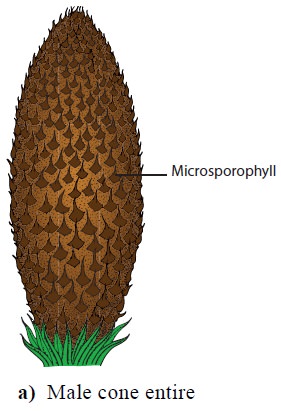

Male cone
The male cone or staminate cone are borne singly on
the terminal part of the stem. The growth of the stem is continued by the
formation of axillary buds at the base of the cone. The male cone is displaced
to one side showing sympodial growth in the stem. Male cones are stalked,
compact, oval or conical and woody in structure. It consists of several
microphylls which are arranged spirally around a central cone axis.
Microsporophylls
![]()
![]()
![]()
Microsporophylls are flat, leaf-like and woody
structures with narrow base and expanded upper portion. The upper expanded
portion becomes pointed and is called apophysis. The narrow base is attached to
the cone axis. Each microsporophyll contains thousands of microsporangia in
groups called sori on abaxial (lower) surface. Development of sporangium is of
Eusporangiate type. The spore mother cell undergoes meiosis to produce halpoid
microspores. Each Microsporangium bears large number of microspores or pollen
grains. Each sporangium is provided with a radial line of dehiscence, which
helps in the dispersal of spores. Each microspore (Pollen grain) is a rounded,
unicellular and uninucleate structure surrounded by outer thick exine and an
inner thin intine. The microspore represents the male gametophyte.
Megasporophylls
The megasporophylls of Cycas are not organised into cones. They occur in close spirals
around the tip of the stem of female plant. The megasporophylls are flat and
measuring 15 -30 cm in length. Each megasporophyll is differentiated into a
basal stalk and an upper leaf like portion. The ovules are attached to the
lateral side of the sporophyll. The ovules contain megaspore and it represent
the female gametophyte.
Structure of Ovule
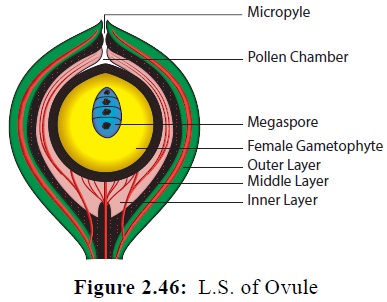
Pollination and Fertilization.
Pollination is carried out by wind and occurs at 3
celled stage(a prothallial cell, a large tube cell and a small generative
cell). Pollen grains gets lodged in the pollen chamber after pollination. The
generative cell divides into a stalk and a body cell. The body cell divides to
produce two large multiciliated antherozoids or sperms. During fertilization,
one of the male gamete or multiciliated antherozoid fuses with the egg of the
archegonium to form a diploid zygote (2n). The endosperm is haploid. The
interval between pollination and fertilization is 4- 6 months. The zygote
undergoes mitotic division and develops into embryo. The ovule is transformed
into seed. The seed has two unequal cotyledons. Germination is hypogeal. The
life cycle shows alternation of generations (Figure 2.47).
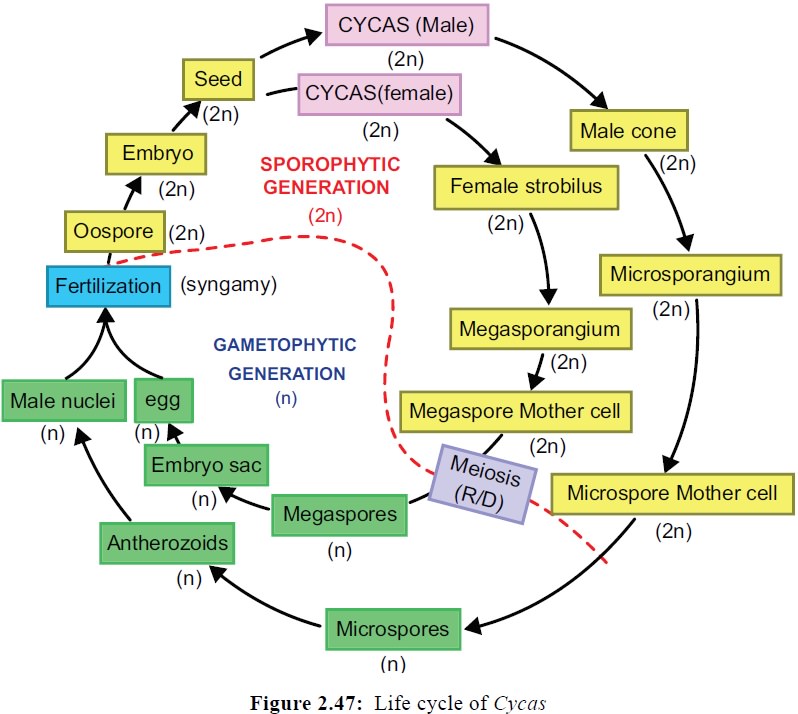
5. Pinus
Class – Coniferopsida
Order – Coniferales
Family –Pinaceae
Genus - Pinus
Pinus is a tall
tree, looks conical in appearance and
forms dense evergreen forest in the North temperate and sub-alpine regions of
the world. They mostly grow in high altitudes (ranging from 1,200 to 3,000
metres). Some species of this genus include, Pinus roxburghii, P. wallichiana,
P. gerardiana and P. insularis.
External features
The plant body is sporophyte and is differentiated
into root, stem and leaves.
The main stem is branched. The branches are
dimorphic with long and short branches (Figure 2.48).
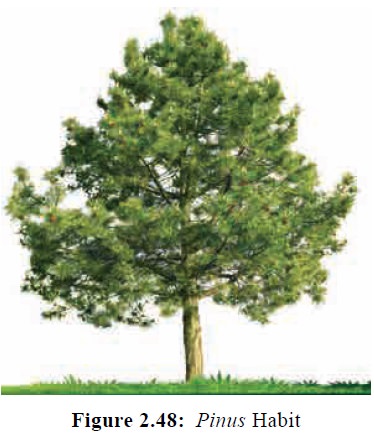
Root
Tap root system is found in Pinus. The root hairs are not well developed and the roots are
covered with fungal hyphae called mycorrhizae.
Stem
The stem is cylindrical, erect, woody and branched.
The branches are monopodial. The branches are of two types.
(i) Long shoots or branches of unlimited growth,
(ii) Dwarf shoot or branches of limited growth
(i)
Long
shoots or branches of unlimited growth
The long shoot is present on the main trunk the apical buds grow indefinitely, They shorten gradually towards the tip, thus providing a pyramidal appearance to the tree. These branches bear scale leaves only.
(ii) Dwarf shoot or branches of limited growth
These branches do not have apical buds and hence
show only limited growth. They develop in the axils of scale leaves and bear
both scale and foliage leaves.
Leaves
There are two types of leaves 1. scale leaves, 2.
foliage leaves
1. Scale leaves:
They are dark, brown, membranous, thin and small.
They are present on both long and dwarf shoots. Their function is to protect
young buds. The scale leaves on the dwarf shoots have a distinct midrib and are
called “Cataphylls”.
2. Foliage leaves:
The foliage leaves are green angular and needle
like structures. They are borne on the dwarf shoot. A dwarf shoot with a group
of needle like foliage leaves is known as foliar
spur. The number of needles per dwarf shoot varies among the species. It
may be one (Pinus monophylla), two (P. sylvestris), three (P. geraradiana), four (P. quadrifolia) and five (P. excelsa).
Internal Structure
T.S. of root
The internal structure of root reveals the presence
of epiblema, cortex and stele.
The epiblema is made up of single layer of
parenchymatous cells. Cortex is the wide zone and consists of parenchyma. Some
of the cells have resin ducts. A single layered endodermis with suberised wall
is present and is impregnated with tannins.A multilayered pericycle made up of
parenchyma is present. Vascular tissue is radial, diarch with exarch xylem. The
protoxylem bifurcates to form a ‘Y’ shaped structure and a resin duct lies in
between the two arms of protoxylem. Secondary growth is present (Figure 2.49).
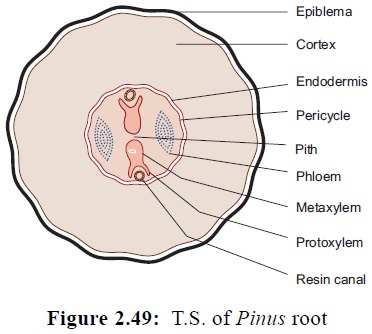
T.S. of Stem
The internal organization of the stem shows three
regions namely epidermis, Cortex and vascular tissue (Figure 2.50).
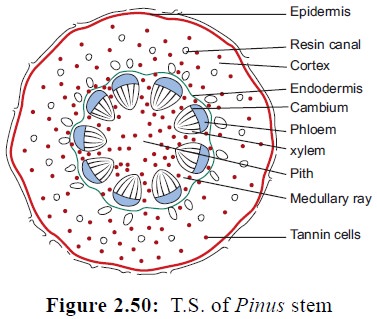
Epidermis is the outermost layer composed of
compactly arranged and heavily cutinized cells. Epidermis is followed by few
layers of sclerenchymatous hypodermis. The cortex consists of thin walled
parenchyma cells. Resin canals and tannin filled cells are present in this
region. Endodermis is indistinguishable from cortical cells. Vascular region is
surrounded by pericycle. A ring consists of five or six vascular bundles are
present. Vascular bundles are conjoint, collateral, open and endarch. Pith and
medullary rays are present. Secondary growth is present and annual rings are
formed.
T.S. of needle or foliage leaf
The internal structure of needle shows xerophytic
adaptations. In cross section the outline appears more or less triangular and
is divided into epidermis, mesophyll and vascular bundles. The epidermis is
single layered and possesses thick cuticle and sunken stomata.Epidermis is
followed by a few layers of sclerenchymatous hypodermis. It is interrupted by
sub-stomatal cavities (Figure 2.51).

Mesophyll is not differentiated into palisade and
spongy parenchyma. Thin walled cells with chloroplasts are present. The cells
are peculiar with numerous small infoldings which project into the cavities.
The infoldings increase the photosynthetic area of the needle leaves Resin
canal is present in the mesophyll. A single layered endodermis separates the
vascular region from the cortex. A multilayered pericycle containing starch is
present. Two types of specialised cells called albuminous cells and tracheidal
cells are present. The former helps
to pass substances from the mesophyll to the phloem while the latter helps in
water conduction and constitutes transfusion tissue. Two vascular bundles are
present. They are separated by sclerenchyma tissue. The Vascular bundles are
conjoint, collateral and open.
![]()
![]()
![]()
Reproduction
Pinus is
heterosporous and produces two types
of spores called. microspores and megaspores. The plants are monoecious. Both
male and female cones or strobili develop on the different branches of the same
plant (Figure 2.52).
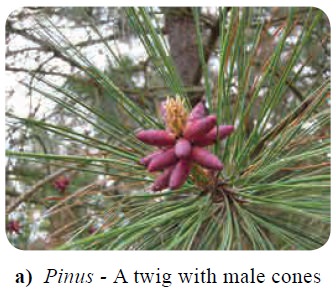

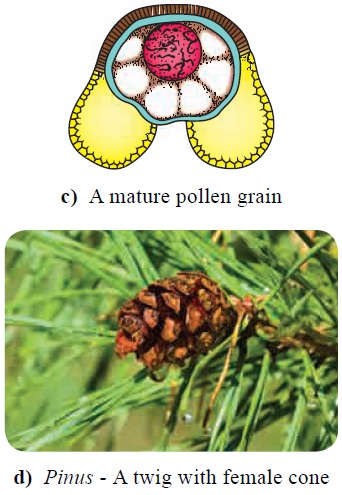
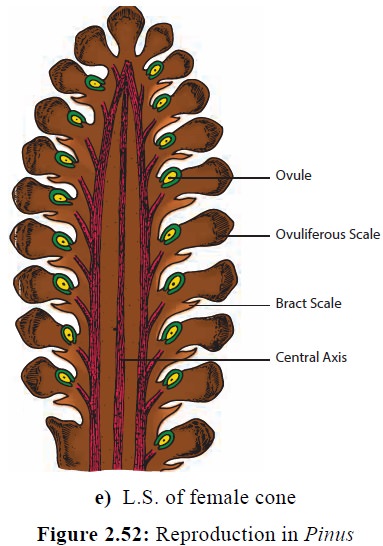
Male cone
![]()
![]()
![]()
Female cone:-
Female cones are formed in the groups of 1 to 4 in
the axils of the scale leaves. The female cone takes about three years to
mature. It has the central axis around which megasporophylls are arranged
spirally. The megasporophyll is the compound structure consisting of two types
of scales. 1. Bract scale (sterile), and 2. Ovuliferous scales (fertile). The
dorsal surface of each ovuliferous scale bears two ovules. Ovules bear
megaspores which represent the female gametophyte.
Pollination and fertilization
In Pinus
wind pollination takes place (Anemophilous). The microspore or pollen grain is
released in the 4 celled stage(two prothallial cell, 1 generative and 1 tube
cell). At the time of pollination a secretion oozes out from the micropyle of
the ovule which entangles pollen grains which helps to lodge them in the pollen
chamber. The tube cell protrudes to form pollen tube. The generative cell
divides to produce stalk cell and body cell. The body cell divides into unequal
male cells. Fertilization takes place after about a year of pollination. The
pollen tube containing two male nuclei penetrates through the micropyle and
reaches the egg. One of the male nuclei fuses with the egg forming diploid
zygote and the remaning one gets degenerated.
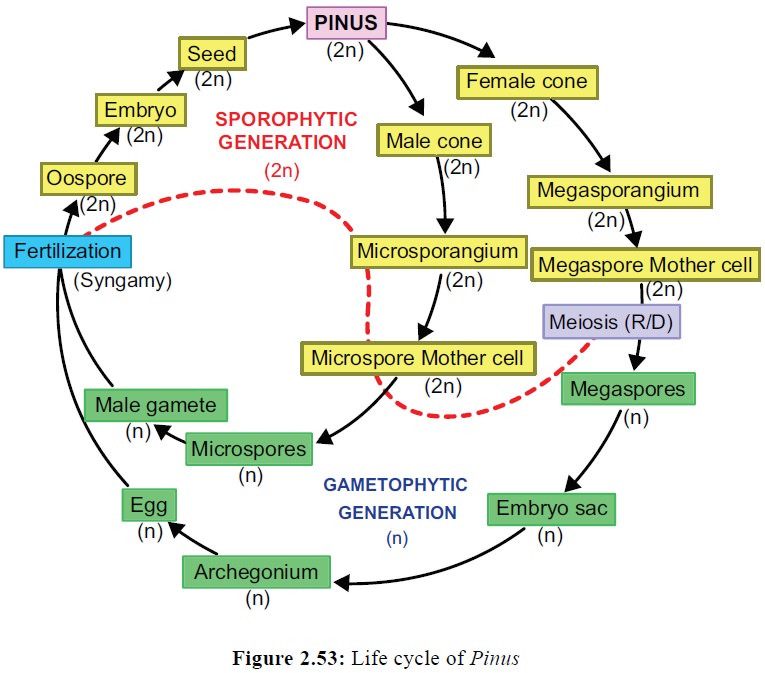
The fertilized egg (zygote) undergoes mitotic division and develops
into an embryo. Polyembryony is present. The embryo undergoes several changes
and finally becomes a winged seed. The seed germination is epigeal. Life cycle
of Pinus shows alternation of
generation (Figure 2.53).
Know about Fossil plants
T he National wood fossil park is situated in
Tiruvakkarai, a Village of Villupuram district of Tamil Nadu. The park contains
petrified wood fossils approximately 20 million years old. The term ‘form
genera’ is used to name the fossil plants because the whole plant is not
recovered as fossils instead organs or parts of the extinct plants are obtained
in fragments. Shiwalik fossil park-Himachal Pradesh, Mandla Fossil park-Madhya
Pradesh, Rajmahal Hills–Jharkhand, Ariyalur – Tamilnadu are some of the fossil
rich sites of India.
Some of the fossil representatives of different
plant groups are given below
Fossil algae - Palaeoporella,
Dimorphosiphon
Fossil Bryophytes – Naiadita, Hepaticites, Muscites
Fossil Pteridophytes – Cooksonia, Rhynia,, Baragwanthia,
Calamites
Fossil Gymnosperms – Medullosa, Lepido-carpon, Williamsonia, Lepidodendron
Fossil Angiosperms – Archaeanthus, Furcula
Related Topics